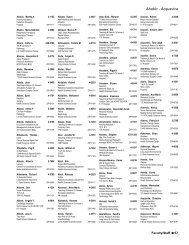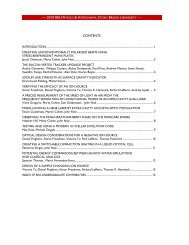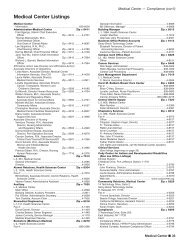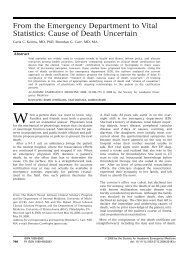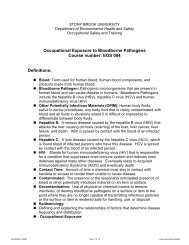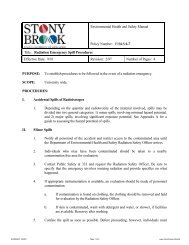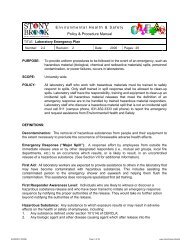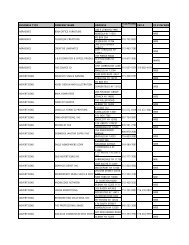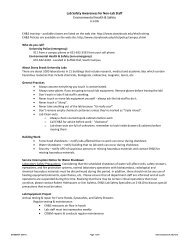Map Cataloging Basics - Stony Brook University
Map Cataloging Basics - Stony Brook University
Map Cataloging Basics - Stony Brook University
You also want an ePaper? Increase the reach of your titles
YUMPU automatically turns print PDFs into web optimized ePapers that Google loves.
MAP CATALOGING: LEARNING THE BASICS<br />
Saturday, June 16, 2001<br />
9:00 am – 12:30 pm<br />
San Francisco, California<br />
Handout Index<br />
Susan M. Moore<br />
<strong>University</strong> of Northern Iowa<br />
(319) 273-3661<br />
susan.moore@uni.edu<br />
and<br />
Lucinda M. Hall<br />
Dartmouth College<br />
(603) 646-0962<br />
lucinda.m.hall@dartmouth.edu<br />
Resources………………………………………………………………………………….2<br />
Major Differences between Book and <strong>Map</strong> <strong>Cataloging</strong><br />
(Minus mathematical and physical descriptions)………………………………………….4<br />
Scale……………………………………………………………………………………….8<br />
Scale Exercises…………………………………………………………………………...12<br />
Projection and Coordinates………………………………………………………………14<br />
Measuring Examples……………………………………………………………………..15<br />
How to Date a Road <strong>Map</strong>………………………………………………………………...16<br />
Subject Headings………………………………………………………………………...20<br />
Scale Exercises Answers………………………………………………………………...22<br />
Prepared by Susan M. Moore, <strong>University</strong> of Northern Iowa
<strong>Cataloging</strong> Rules (in addition to AACR2rev.)<br />
RESOURCES<br />
Cartographic materials : a manual of interpretation for AACR2 / prepared by the Anglo-<br />
American <strong>Cataloging</strong> Committee for Cartographic Materials. Chicago : ALA ; Ottawa : CLA,<br />
1982. ISBN 0-8389-0363-0 (ALA) ISBN 0-88802-169-0 (CLA) [Out of print; however a new<br />
edition will be coming out in 2001]<br />
<strong>Map</strong> cataloging manual / prepared by the Geography and <strong>Map</strong> Division, Library of Congress.<br />
Washington, D.C. : <strong>Cataloging</strong> Distribution Service, Library of Congress, 1991. ISBN 087071-<br />
361-2 [Also available on Cataloger=s Desktop]<br />
<strong>Map</strong>s and related cartographic materials : cataloging, classification, and bibliographic control /<br />
Paige G. Andrew and Mary Lynette Larsgaard, editors. New York : Haworth Press, 1999. ISBN<br />
0-7890-0778-9 (hbk.) ISBN 0-7890-08130 (pbk.) [also published as vol. 27, nos. 1/2 and 3/4 of<br />
<strong>Cataloging</strong> and Classification Quarterly]<br />
Guidelines for distinguishing cartographic materials on computer file carriers from other<br />
materials on computer file carriers / prepared by the Library of Congress, <strong>Cataloging</strong> Policy and<br />
Support Office, Network Development and MARC Standards Office, Geography and <strong>Map</strong><br />
Division, and<br />
Special Materials <strong>Cataloging</strong> Division. January 1998. On the Web at:<br />
http://lcweb.loc.gov/marc/cfmap.html<br />
Natural Scale Indicator/<strong>Map</strong> Scale Indicator<br />
Plastic version (approx. $5-$10<br />
Heavy paper version (Possibly no cost)<br />
Department of Geography<br />
U.S. Department of Commerce<br />
Memorial <strong>University</strong> of Newfoundland<br />
National Oceanic & Atmospheric<br />
Administration<br />
St. John’s, Newfoundland A1B 3XP Canada National Ocean Service<br />
Physical Science Services Branch<br />
http://www.mun.ca/geog/muncl/Products/msi.htm Rockville, MD 20852<br />
For general information about maps and map librarianship<br />
<strong>Map</strong> librarianship : an introduction / Mary Lynette Larsgaard. 3rd ed. Englewood, Colo. :<br />
Libraries Unlimited, 1998. ISBN 1-56308-474-0 (Includes a very extensive bibliography and a<br />
lot of excellent information on cataloging issues as well as other aspects of map librarianship)<br />
USGS maps (USGS brochure with examples of different types of maps and relief).<br />
Request from: USGS <strong>Map</strong> Distribution, Box 25286, Denver, CO 80225<br />
2<br />
<strong>Map</strong> <strong>Cataloging</strong>: Learning the <strong>Basics</strong>
For information about mapmaking and/or map projections<br />
Choosing a world map : attributes, distortions, classes, aspects / Committee on <strong>Map</strong> Projections<br />
of the American Cartographic Association. Falls Church, Va. : American Congress on<br />
Surveying and <strong>Map</strong>ping, c1988. Special Publication no. 2. ISBN 0-96134592-6<br />
<strong>Map</strong> appreciation / Mark Monmonier, George A. Schnell. Englewood Cliffs, N.J. : Prentice<br />
Hall, c1988. ISBN 0-13-556052-7<br />
<strong>Map</strong> projections : a reference manual / Lev M. Bugayevskiy, John P. Snyder. Bristol, PA :<br />
Taylor and Francis, 1995. ISBN 0-7484-0303-5<br />
<strong>Map</strong> use : reading, analysis, and interpretation / Phillip C. Muehrcke, Juliana O. Muehrcke. 4th<br />
ed. Madison, WI : JP Publications, c1998. ISBN 0-9602978-4-7<br />
Matching the map projection to the need / Committee on <strong>Map</strong> Projections of the American<br />
Cartographic Association. Bethesda, Md. : American Congress on Surveying and <strong>Map</strong>ping,<br />
c1991. Special Publication no. 3. ISBN 0-9613459-5-0<br />
Web resources<br />
http://www.sunysb.edu/libmap/magert1.htm <strong>Map</strong> and Geography Round Table, American<br />
Library Association / webmaster: David Allen.<br />
http://www.tlcdelivers.com/tlc/crs/map0001.htm <strong>Map</strong> <strong>Cataloging</strong> Manual / content by the<br />
Library of Congress; hosted by The Library Corporation.<br />
http://ucs.orst.edu/~reeset/tools.html Oregon State <strong>University</strong> <strong>Map</strong> <strong>Cataloging</strong> -- Cartographic<br />
<strong>Cataloging</strong> Tools / Terry Reese.<br />
http://www.konbib.nl/kb/resources/frameset_kb.html?/kb/skd/skd/mathemat.html Mathematical<br />
data for bibliographic descriptions of cartographic material and spatial data / Jan Smits.<br />
http://www.waml.org/maptools.html Western Association of <strong>Map</strong> Libraries' <strong>Map</strong> Librarian's<br />
Toolbox / Linda Zellmer.<br />
Based on handouts prepared by Catherine Gerhart, <strong>University</strong> of Washington<br />
3<br />
<strong>Map</strong> <strong>Cataloging</strong>: Learning the <strong>Basics</strong>
Major Differences between Book and <strong>Map</strong> <strong>Cataloging</strong><br />
(minus Mathematical and Physical Description)<br />
Note:<br />
AACR2=Anglo-American <strong>Cataloging</strong> Rules, 2 nd ed., revised<br />
CM=Cartographic Materials<br />
MCM=<strong>Map</strong> <strong>Cataloging</strong> Manual<br />
I. Fixed Fields<br />
A. All cartographic materials whether digital or not are coded Type “e”. (Note: 034 and<br />
255 required for all type “e” records)<br />
There are five initial determinations to make when beginning to catalog a<br />
cartographic item.<br />
Is it an atlas?<br />
Atlases are collections of maps intended to be used like a book and shelve together that<br />
can be bound or loose-leaf, flat or folded, in cases, boxes, portfolios, or folders. (CM<br />
p.185)<br />
Is it a single map sheet?<br />
Single maps can be printed on two or more sheets (usually less than 12), are published<br />
together, have incomplete borders, and, have the main title and legend on only one of the<br />
sheets (MCM 7.2)<br />
Is it a maps set/series?<br />
<strong>Map</strong> set/series are collections of maps, with common unifying features, often similar<br />
sized, with the same scale and relief/symbols. They may form a single map when<br />
assembled, often will have a collective title and individual sheet designations. A<br />
distinguishing feature from single maps is that maps set/series are intended to be used<br />
individually as well as together. (MCM 7.2-7.4)<br />
Is it a serial?<br />
<strong>Map</strong> serials are infrequent but when they do occur they look very much like regular<br />
serials with serial title constant from issue to issue and a numbering system which<br />
includes issue number and date of issue. (CM p. 177)<br />
Is it a digital map?<br />
When deciding whether a computer should be considered a cartographic<br />
materials consult the "Guidelines for Distinguishing Cartographic Materials<br />
on Computer File Carriers from other Materials on Computer File Carriers"<br />
This document can be found at http://lcweb.loc.gov/marc/cfmap.html.<br />
B. 006 for maps, digital maps and atlases. Optionally add the following:<br />
1. 006 for accompanying maps<br />
2. 006 for book aspects of atlases<br />
LC is adding these when there is substantial text in an atlas<br />
so you’ll see it on copy.<br />
3. 006 for computer files aspects of digital maps<br />
4<br />
<strong>Map</strong> <strong>Cataloging</strong>: Learning the <strong>Basics</strong>
C. 007 for maps, digital maps and atlases. Always add a map 007 when use the type<br />
code “e”. This will mean that digital maps will have a map 007 and a computer file<br />
006.<br />
D. 008 (fixed fields) (Note that the 006 fields are defined the same as the 008)<br />
II. Chief Source<br />
1. CrTp (Type of Cartographic Material)– use “a” Single map for digital<br />
maps per LC.<br />
2. Proj (Projection) - only used if piece specifies<br />
3. Relf (Relief) - use with relief note<br />
4. SpFm (Special Format Characteristics) - use to indicate whether map<br />
is also something like a wall map, calendar, game, puzzle, etc. (May<br />
also bring out more fully these characteristics in the 006)<br />
Note: For digital maps, although the type code and fixed fields use the map format, the<br />
cataloging rules still instruct that the primary chapter for these materials is Chapter 9 with<br />
instructions taken from Chapter 3 as needed. So, only the purely map fields discussed below will<br />
pertain to digital maps. For instance, use Chapter 9 for chief source of information for digital<br />
maps, not Chapter 3 chief source.<br />
A. No straightforward title page equivalent exists for maps since the chief source is the<br />
entire map. (AACR2 3.0B2)<br />
B. Title is chosen on the basis of sequence or layout. If the layout is not clear the most<br />
comprehensive title (includes both subject and geographic area) is used. (CM 1B8b<br />
and AACR2 3.1B3)<br />
C. The definition of prominence is much different. Prominent is anywhere on the map<br />
even in very little type. (AACR2 0.8)<br />
III. Main entry<br />
A. Main entry is based less on prominence and more on who did what.<br />
B. The cartographer has to be more than just the mechanical drawer or tracer to get the<br />
main entry.<br />
C. The corporate body must be a map-making body to get main entry. (AACR2<br />
21.1B2f)<br />
D. There is often no statement of responsibility.<br />
5<br />
<strong>Map</strong> <strong>Cataloging</strong>: Learning the <strong>Basics</strong>
IV. Title proper<br />
V. GMD<br />
VI. Publisher<br />
A. Major difference is that you are encouraged to bracket additional area (place name)<br />
information in the subtitle if it is not present in the title. (AACR2 3.1E2)<br />
A. Since LC does not use a GMD in their system, OCLC has asked that contributors to<br />
their database also not use it. Many other libraries have decided not to add locally.<br />
Remember for digital maps the GMD will be [computer file] since you’re using primarily<br />
Chapter 9.<br />
A. DO NOT bracket publisher information repeated from elsewhere in the description<br />
(e.g., 245 or quoted 500 note) even if it appears only once on the map. (MCM p. 2.6)<br />
Note: this does not include the date. If the date appears only once on the map and is<br />
transcribed as any other part of the description (such as the title, edition or notes), it is<br />
bracketed in the date of publication.<br />
VII. Notes<br />
A. The first notes are unique to maps. They show:<br />
u additional content of the map not found in the title,<br />
u justification for the date of situation in the call number, and<br />
u relief on main map (AACR2 3.7B1 and MCM p. 3.6-3.12)<br />
Kinds of relief include:<br />
contours<br />
satellite imagery<br />
form lines gradient tints<br />
spot heights hachures<br />
shading<br />
pictorial<br />
soundings landforms<br />
B. Give the source of the title proper whenever it is not taken from the recto of the map,<br />
namely, when it is taken from the verso, cover, panel, or accompanying text. (MCM<br />
p. 3.14 - p. 3.18)<br />
C. A statement of responsibility note may contain the name of the copyright holder if an<br />
access point is needed. (MCM p. 2.2 and p. 5.2)<br />
D. Orientation (MCM 3.23)<br />
500 Oriented with north to [left, bottom, or right] or,<br />
500 Oriented with north toward [the upper left, the lower right, etc.]<br />
6<br />
<strong>Map</strong> <strong>Cataloging</strong>: Learning the <strong>Basics</strong>
E. Contents<br />
1. The order of the notes in this area is very specific: recto, verso, cover. (MCM<br />
p. 3.30)<br />
2. There are specific definitions attached to various terms used in these notes.<br />
(MCM p. 3.32-3.42)<br />
Based on handouts prepared by Catherine Gerhart, <strong>University</strong> of Washington<br />
7<br />
<strong>Map</strong> <strong>Cataloging</strong>: Learning the <strong>Basics</strong>
SCALE<br />
Representative Fractions<br />
map distance<br />
ground distance in same units<br />
1. 1:600 ("large scale")<br />
034 1 a |b 600<br />
255 Scale 1:600.<br />
2. 1:300,000,000 ("small scale")<br />
034 1 a |b 300000000<br />
255 Scale 1:300,000,000.<br />
Verbal Scale Statements (63,360 inches in a mile; 100,000 cm. in a km.)<br />
a converter like http://www.onlineconversion.com/length.htm is helpful<br />
3. One inch to one mile.<br />
034 1 a |b 63360<br />
255 Scale [1:63,360]. 1 in. to 1 mile.<br />
4. 1 centimeter equals approximately 10.5 kilometers.<br />
034 1 a |b 1050000<br />
255 Scale [ca. 1:1,050,000]. 1 cm. = approx. 10.5 km.<br />
Graphic Scales<br />
use Natural Scale Indicator is available<br />
034 1 a |b 12250<br />
255 Scale [ca. 1:12,250].<br />
034 1 a |b 1900800<br />
255 Scale [ca. 1:1,900,800].<br />
8<br />
<strong>Map</strong> <strong>Cataloging</strong>: Learning the <strong>Basics</strong>
Scale, p. 2<br />
Some Combination of the Above<br />
7.<br />
034 1 a |b 1550000<br />
255 Scale 1:1,550,000. 1 cm. = 15.5 km. Or 1 in. = 24.5 miles.<br />
8. Scale varies<br />
Non-Representative Fraction Scale Statements<br />
Use when the scale within a single map varies across the map and the outside values are not<br />
known.<br />
034 0 a<br />
255 Scale varies.<br />
If the outside values are known, record both scales, connected by a hyphen.<br />
034 3 a |b 19000 |b 33000<br />
255 Scale 1:19,000-1:33,000.<br />
9. Scales differ<br />
Use when there are three or more maps of equal importance on the sheet or in the set and their<br />
scales are not the same.<br />
034 0 a<br />
255 Scales differ.<br />
When there are two or more maps of equal importance with only two different scales, two<br />
scale statements are given. Give the larger scale first, unless the smaller scale is clearly<br />
predominant or there are only two maps with no collective title. In the latter case, give the scales<br />
in the order corresponding to the individual titles in the title area. (If all the information in the<br />
mathematical data area is the same for two maps of equal importance, only one mathematical<br />
data area is given.)<br />
9<br />
<strong>Map</strong> <strong>Cataloging</strong>: Learning the <strong>Basics</strong>
Scale, p. 3<br />
034 1 a |b 25000<br />
034 1 a |b 30000<br />
255 Scale 1:25,000.<br />
255 Scale 1:30,000.<br />
10. Scale not given<br />
Use only when the only way to determine the scale is to compare the map with a map of<br />
known scale (see below) and the library's policy is not to do so.<br />
034 0 a<br />
255 Scale not given.<br />
11. Scale indeterminable<br />
Use only when there is truly no way to determine the scale using one of the methods<br />
described here, including the use of the comparison method.<br />
034 0 a<br />
255 Scale indeterminable.<br />
12. Not drawn to scale<br />
Use for bird's-eye views, map views, maps of imaginary places, celestial charts and other<br />
maps with nonlinear scales which do not give scale information on the item and which are not<br />
drawn to scale.<br />
034 0 a<br />
255 Not drawn to scale.<br />
Use of Latitude<br />
Use a scale indicator, if available. If using a ruler, the formual is<br />
___n_____<br />
11,000,000<br />
where n<br />
is the number of centimeters measured on the map for 1 0 latitude<br />
11,000,000 is the approximate number of centimeters on the ground for 1 0 latitude<br />
To get the representative fraction, divide the numerator and the denominator by n, giving<br />
you 1 to the left of the colon and 11,000,000/n to the right of the colon.<br />
10<br />
<strong>Map</strong> <strong>Cataloging</strong>: Learning the <strong>Basics</strong>
Scale, p 4<br />
13. __________________ 44 0<br />
__________________ 45 0<br />
034 1 a |b 5500000<br />
255 Scale [ca. 1:5,500,000].<br />
On scale indicator (1 0 latitude):<br />
On ruler:<br />
1 0 mark crosses at about 5,500,000 2 cm. = 1 0<br />
1 0 = 5,500,000 2/2 = 11,000,000/2<br />
1:5,500,000 1:5,500,000<br />
When there is more than one degree latitude between lines, remember to multiply<br />
11,000,000 by the number of degrees represented before applying the formula.<br />
14. ________________ 30 0<br />
________________ 15 0<br />
034 1 a |b 112500000<br />
Scale [ca. 1:112,500,000].<br />
On scale indicator (1 0 latitude):<br />
On ruler:<br />
15 0 mark crosses at 7,500,000 1.5 cm. = 15 0<br />
15 0 = 7,500,000 x 15 1.5 cm. = 15 x 11,000,000<br />
1: 112,500,000 1.5/1.5 = 165,000,000/1.5<br />
1: 110,000,000<br />
(Note that both methods are only approximations; a difference of 2,500,000 at this small scale is<br />
not very significant.)<br />
Comparison with a <strong>Map</strong> of Known Scale<br />
--Choose a map of known scale that shares identifiable points with the map of unknown scale.<br />
--Measure the distance between two identifiable points on the map of known scale.<br />
--Measure the distance between the same two points on the map of unknown scale, using the<br />
same unit of measurement.<br />
-- Apply the following equation: n=m x a/b<br />
where n is the denominator of the RF of the map of unknown scale<br />
m is the denominator of the RF of the map of known scale<br />
a is the distance between the two points on the map of known scale<br />
b is the distance between the two points on the map of unknown scale<br />
This is the least accurate way of determining scale. The Library of Congress does not use this<br />
method of calculating scale.<br />
11<br />
<strong>Map</strong> <strong>Cataloging</strong>: Learning the <strong>Basics</strong>
SCALE EXERCISES<br />
1. One inch represents six miles<br />
2. 1 centimeter on the map represents 20 kilometers on the ground<br />
3. One inch equals approximately 40 miles or 64.4 kilometers<br />
4. One inch: approximately 17.3 miles<br />
8.<br />
12<br />
<strong>Map</strong> <strong>Cataloging</strong>: Learning the <strong>Basics</strong>
Scale Exercises, p. 2<br />
9. _______________________ 30 0<br />
_______________________ 32 0<br />
10. ______________________ 17 0<br />
_______________________ 22 0<br />
13<br />
<strong>Map</strong> <strong>Cataloging</strong>: Learning the <strong>Basics</strong>
PROJECTION AND COORDINATES<br />
PROJECTION refers to the system used to represent information about the spherical surface of the<br />
Earth on a flat surface. There are many different types of projections. You don’t need to understand any<br />
of them to catalog a map. Projection is not reflected in the 034, but is coded in the fixed fields.<br />
Transcribe a statement of projection found on the map, its container or case, or accompanying printed<br />
material in the mathematical data (255) area. Transcribe the statement in English, regardless of the<br />
language in which it appears. Use standard abbreviations (e.g. “proj.” for “projection”) and numerals in<br />
place of words. Capitalize proper names. (Cartographic Materials, 3C) (Note: The <strong>Map</strong> <strong>Cataloging</strong><br />
Manual says to capitalize the first word as well. OCLC documentation follows LC).<br />
255 Scale 1:150,000 ; |b Transverse Mercator proj.<br />
COORDINATES refer to the geographical grid lines used to pinpoint locations on the earth.<br />
– Longitude lines (or “meridians”) run north/south between the poles<br />
– Latitude lines (or “parallels”) run east/west parallel to the equator<br />
Both sets of lines are measured in degrees, minutes, and seconds from a standard base line (the number<br />
represents the angle measured between the subject line and the base line through the center of the earth).<br />
For longitude, the standard base line (or “prime meridian”) is usually the line which passes through<br />
Greenwich, England. However, any meridian can be used as a prime meridian. Older maps often have<br />
non-Greenwich prime meridians and this is usually indicated on the map. Longitude is counted 180 0 east<br />
or west from the prime meridian. Record longitude from westernmost to easternmost points.<br />
For latitude, the standard base line is the equator. Latitude is counted 90 0 north or south from the equator.<br />
Record latitude from northernmost to southernmost points.<br />
Give the coordinates in the following order:<br />
westernmost extent, easternmost extent, northernmost extent, southernmost extent<br />
Enter coordinates in the 034 field in the form HDDDMMSS (hemisphere, degrees, minutes, seconds,<br />
where hemisphere is W, E, N, or S as appropriate).<br />
034 1 a |b 1000000 |dW1013015 |e W0203000 |f N0490000 |g N0343015<br />
255 Scale 1:1,000,000 |c (W 101 0 30'15"–W 20 0 30'00"/N 49 0 00'00"–N 34 0 30'15").<br />
034 1 a |b 2000 |dW0745000 |e W0744000 |f N0450500 |g N 0450000<br />
255 Scale [ca. 1:2,000] |c (W 74 0 50'–W 74 0 40'/N 45 0 05"–N 45 0 00').<br />
034 1 a |b 500000 |d E0790000 |e E0860000 |f N0200000 |g N0120000<br />
255 Scale 1:500,000 |c (E 79 0 –E 86 0 /N 20 0 --N 12 0 ).<br />
INPUTTING TIP: The correct symbols for degrees, minutes and seconds are special characters:<br />
Degrees: Superscript zero<br />
Minutes (and feet): Miagkii znak<br />
Seconds (and inches): Tverdyi znak<br />
Coordinates for the moon, planets, and other celestial bodies are given in a note.<br />
14<br />
<strong>Map</strong> <strong>Cataloging</strong>: Learning the <strong>Basics</strong>
MEASURING EXAMPLES<br />
1. 1 map : |b col. ; |c 20 x 27 cm.<br />
– Measure height x width rounded up to the nearest cm. (with map in reading position).<br />
2. 1 map : |b col. ; |c 51 x 75 cm., folded to 23 x 11 cm.<br />
– Also give folded size if map is designed to be folded (has panel or cover).<br />
3. 1 map : |b col. ; |c 58 x 48 cm.<br />
– If cartographic details extends beyond the neat line, include it in the measurement<br />
4. 1 map ; |c 17 x 25 cm.<br />
– No neat line: measure cartographic extent, which could be the entire sheet.<br />
5. 1 map : |b col. ; |c 20 x 27 cm., on sheet 43 x 28 cm., folded to 22 x 10 cm.<br />
– Also give sheet size if either dimension of map is less the half the same dimension of the sheet.<br />
6. 1 map in 3 segments : |b col. ; |c 144 x 22 cm., on sheet 55 x 65 cm.<br />
– <strong>Map</strong> in segments at consistent scale: measure as if segments are joined; also give sheet size<br />
7. 2 maps on 1 sheet : |b both sides, col. ; |c 32 x 49 cm. and 32 x 55 cm., on sheet 93 x 65 cm.,<br />
folded to 23 x 11 cm.<br />
– 2 maps of equal importance (collective title); measure both maps; also give sheet size<br />
8. 1 map on 2 sheets : |b col. ; |c 121 x 194 cm., sheets 137 x 107 cm<br />
– <strong>Map</strong> on multiple sheets: measure as if sheets joined, excluding any overlap; also give sheet size<br />
9. 3 maps on 1 sheet :|bboth sides, col. ;|c73 x 48 cm. or smaller on sheet 75 x 50 cm., folded to<br />
25 x 13 cm<br />
– 3 or more maps or sheets, give the greatest height of any of them followed by the greatest<br />
width of any of them, followed by “or smaller”<br />
10. 1 map : |b both sides, col. ; |c 104 x 109 cm., on sheet 107 x 68 cm., folded to 23 x 11 cm.<br />
– 1 map continued on back: measure as if one map, excluding overlap; also give sheet size<br />
11. 1 map : |b col. ; |c 43 x 62 cm., folded to 23 x 11 cm.<br />
– A continuation ancillary map is not included in measurement; mention it in a note (but<br />
coordinates do take continuation into account)<br />
12. 1 map : |b col. ; |c 69 cm. in diam., on sheet 74 x 74 cm.<br />
– Circular map: give diameter and label as such; also give sheet size<br />
13. 1 map : |b col. ; |c on sheet 46 x 61 cm.<br />
– <strong>Map</strong> too difficult to measure: simply give sheet size.<br />
15<br />
<strong>Map</strong> <strong>Cataloging</strong>: Learning the <strong>Basics</strong>
HOW TO DATE A ROAD MAP<br />
Information courtesy of Peter L. Stark,<br />
With additions from Mark A. Bozanich and Velma Parker<br />
Most maps are easily dated either by a prominent date on the cover or in the map legend. But<br />
there are still many maps on which no date can be found. Rand McNally and H.M. Gousha have<br />
used a code hidden on a map margin to date their maps. These codes are explained below.<br />
General Drafting has not used such a code, yet they have varied their dating and an explanation<br />
is given for them as well. There is also a brief explanation of the coding used by Geographers A-<br />
Z <strong>Map</strong> Company. For other map publishers, it is recommended that you check the web site<br />
compiled by Phil Hoehn at http://www.waml.org/datecode.html.<br />
When a map is undated, dates must be determined by comparing the map to a map of known<br />
date. Many companies also changed their covers each year, so that once a particular cover<br />
design is dated, other maps of the same design are considered to have the same date. But this<br />
method of comparing covers of like design is prone to possible error, so care should be taken<br />
when using this method.<br />
When dealing with older maps, it is helpful to remember that U.S. route numbers first appeared<br />
in 1926 but did not show on most maps until 1927. Many states numbered their roads well<br />
before 1926.<br />
The detailed tables that are included in this handout may also be used to some degree to date a<br />
map. Most companies have used different publishers over the years as well as both expanding<br />
and contracting the territory they serve, thus helping to limit the possibilities.<br />
Rand McNally <strong>Map</strong> Date Codes<br />
Over the years, Rand appears to have used a number of "systems" to date their maps. All<br />
variations may not be explained here -- but most maps should still be able to be dated. One big<br />
exception, in the 1920s some Rand maps have no letters or numbers at all and these must be<br />
dated by comparing them to know dated maps.<br />
First, Rand used a simple letter code, A for 1919, B for 1920, through Z in 1944. However,<br />
some years prior to 1944 numbers began to appear after the letter. If the set of numbers has four<br />
digits, the first two digits either indicate the year the base map was drafted while the second two<br />
digits either indicate the year the first Rand map was made of the area (the original base) or<br />
simply a code for the area covered. The latter seems more likely except that it limits Rand to one<br />
hundred areas. If only two digits exist after the letter, they seem to be a code for the area.<br />
After 1944 the letter was replaced by a one or two digit year preceding the above series of digits<br />
and often separated by a hyphen. From 1945 to 1965, only the last digit of the year was used.<br />
16<br />
<strong>Map</strong> <strong>Cataloging</strong>: Learning the <strong>Basics</strong>
To distinguish 1945 from 1955 from 1965 generally requires common sense -- look at the<br />
Census date if given, interstate highways, etc. From 1966 to the present, the last two digits of the<br />
year are used.<br />
At some point the series of four digits was increased to six digits although this now has been<br />
discontinued. It is thought these extra digits indicate the number of printings and would change<br />
for each oil company or other distributor. Lastly, still one or two more digits were added after<br />
the above series of digits and are separated by a hyphen. These represent the number of editions<br />
(possibly updates) to the base map through the current map.<br />
Examples:<br />
Z 4424 The Z indicates a 1944 printing, the 44 shows that the base map was newly drawn this<br />
year, the 24 either shows the original base map was drawn in 1924 or simply a code signifying<br />
the area covered. (It is a Texaco Illinois map.)<br />
0-3868-4 The 0 indicates either a 1950 or 1960 printing (in this case it is clearly 1950 based on<br />
the map), the 38 shows that the base map was drawn in 1938, the 68 cannot be 1968 and so must<br />
be a code for the area, and the 4 indicates four updates to the base from 1938 to 1950. (It is Gulf<br />
Oil map for Buffalo-Niagara Falls).<br />
Now to all of this may be added a letter N, S, E, or W for North, South, East or West when only<br />
a portion of the base map is used. The presence of a V could indicate a Velox print, though this<br />
is not certain.<br />
A - 1919 K - 1929 U - 1939 0 - 1950, 1960 66 - 1966<br />
B - 1920 L - 1930 V - 1940 1 - 1951, 1961 xx - from 66 on,<br />
C - 1921 M - 1931 W - 1941 2 - 1952, 1962 last two digits<br />
D - 1922 N - 1932 X - 1942 3 - 1953, 1963 of year<br />
E - 1923 O - 1933 Y - 1943 4 - 1954, 1964<br />
F - 1924 P - 1934 Z - 1944 5 - 1945,1955, 1965<br />
G - 1925 Q - 1935 6 - 1946, 1956<br />
H - 1926 R - 1936 7 - 1947, 1957<br />
I - 1927 S - 1937 8 - 1948, 1958<br />
J - 1928 T - 1938 9 - 1949, 1959<br />
H.M. Gousha <strong>Map</strong> Date Codes<br />
The H.M. Gousha Company was founded in 1926 in Chicago by former employees of Rand<br />
McNally and like Rand, used a hidden date. While some of their maps are dated in the legend or<br />
even on the cover, many Gousha maps do no contain an obvious date.<br />
The code used is one or two letters in a bottom map margin, generally with a series of digits and<br />
even another letter. The digits are not relevant to the date; they indicate the map masters for a<br />
filing system. The older the map, the fewer the digits, if any at all. If two groups of letters<br />
17<br />
<strong>Map</strong> <strong>Cataloging</strong>: Learning the <strong>Basics</strong>
appear in the series, check both and use the one that makes the most sense based on the map.<br />
Occasionally, a map code may indicate different dates on each side of the map or with a<br />
particular inset. In this case the map is classified by the newest such date.<br />
Letter A was assigned to 1927, B to 1928, and so forth through Z in 1952. Then AA for 1953,<br />
BB for 1954 and so forth through ZZ in 1978. At this point the code gets confusing, refer to the<br />
table below.<br />
A - 1927 M - 1939 Y - 1951 KK - 1963 WW - 1975 QD - 1987<br />
B - 1928 N - 1940 Z - 1952 LL - 1964 XX - 1976 WJ - 1988<br />
C - 1929 O - 1941 AA - 1953 MM - 1965 YY - 1977 ER - 1989<br />
D - 1930 P - 1942 BB - 1954 NN - 1966 ZZ - 1978 IV - 1990<br />
E - 1931 Q - 1943 CC - 1955 OO - 1967 AB - 1979 SF - 1991<br />
F - 1932 R - 1944 DD - 1956 PP - 1968 AC - 1980 UH - 1992<br />
G - 1933 S - 1945 EE - 1957 QQ - 1969 AN - 1981 GT - 1993<br />
H - 1934 T - 1946 FF - 1958 RR - 1970 MZ - 1982<br />
I - 1935 U - 1947 GG - 1959 SS - 1971 OB - 1983<br />
J - 1936 V - 1948 HH - 1960 TT - 1972 YL - 1984<br />
K - 1937 W - 1949 II - 1961 UU - 1973 CP - 1985<br />
L - 1938 X - 1950 JJ - 1962 VV - 1974 KX - 1986<br />
All maps published after 1987 have the edition year on the copyright statement.<br />
General Drafting Date Codes<br />
General Drafting has not used a date code in the sense of Rand or Gousha. If any problem exists<br />
with GD it is that they use too many dates. The exception is some maps from the 1920s are<br />
completely undated and can only be dated by comparing with maps of known date.<br />
If a date is shown on the cover or in the legend, then that is the date to use. When two dates are<br />
given, such as 1955-1956 or 1970-71, then always use the first year. Many maps also have a<br />
copyright date which is frequently one year earlier than the legend date, in this case use the<br />
legend date. However, if the copyright date is the only date, then use the copyright date.<br />
In the 1960s, the legend frequently contained a month in addition to the year. In these cases,<br />
from January through August, use the year given; but for September through December, use the<br />
next year. This is basically the system GD uses and it will result in common cover designs being<br />
called the same year. (This applies to the years 1962-1966 in the detailed map listings.)<br />
Due to reprintings, it is possible for the same map to exist as 1970 and 1970-71 and similarly for<br />
other years. These are not listed as separate dates but, in this example, only as 1970.<br />
18<br />
<strong>Map</strong> <strong>Cataloging</strong>: Learning the <strong>Basics</strong>
Since the 1940s, most GD maps contain three or four small digits plus a letter in the margin or on<br />
the back cover. This is the month and year of printing and should not be used to date the map<br />
unless nothing else exists. These change for each reprinting. The letter indicates the printing<br />
company. The only one known for sure is W for Western Publishing and Printing Company.<br />
All of the above explains how to determine the date on which the map was issued. But since<br />
about 1958, GD has used a code to date the masters from which the map was created. This date<br />
is coded as a small "A" plus a number in a bottom corner of a map. This number indicates the<br />
year the base map was first drafted. It is not updated unless the base is redrawn. A1 was for<br />
1953. The following table is for quick reference, but IS NOT THE DATE THE MAP WAS<br />
ISSUED.<br />
A1 - 1953 A7 - 1959 A13- 1965 A19 - 1971 A25 - 1977<br />
A2 - 1954 A8 - 1960 A14 - 1966 A20 - 1972 A26 - 1978<br />
A3 - 1955 A9 - 1961 A15 -1967 A21 - 1973 A27 -1979<br />
A4 - 1956 A10 - 1962 A16 - 1968 A22 - 1974 A28 -1980<br />
A5 - 1957 A11 - 1963 A17 - 1969 A23 - 1975 A29 - 1981<br />
A6 - 1958 A12 - 1964 A18 - 1970 A24 - 1976 A30 - 1982<br />
Geographers A-Z <strong>Map</strong> Company<br />
The codes used by the Geographers A-Z <strong>Map</strong> Company are located in or near the border at one<br />
corner of the map. Atlases produced by the company are coded differently and this table should<br />
not be used for them. The code is comprised of three letters, with each letter corresponding to a<br />
different digit. The letters and their corresponding digit are:<br />
J I H G F E D C B A<br />
1 2 3 4 5 6 7 8 9 0<br />
Thus, "FDC" as a code would translate into "578" or May 1978.<br />
19<br />
<strong>Map</strong> <strong>Cataloging</strong>: Learning the <strong>Basics</strong>
SUBJECT HEADINGS FOR CARTOGRAPHIC MATERIALS<br />
Major tools:<br />
Library of Congress Subject Headings (LCSH)<br />
Subject <strong>Cataloging</strong> Manual (SCM)<br />
<strong>Map</strong> <strong>Cataloging</strong> Manual (MCM)<br />
1. Basic subject assignment (MCM Chapter 4)<br />
A. The first subject heading and the classification number should match.<br />
Exception: Classification can be broader than the first subject. This happens<br />
when multiple places are represented on the map so that the first "group" of<br />
subject headings represent the primary subject but the classification number is for<br />
the broader area representing it.<br />
B. Every map of an identifiable place must be assigned a subject heading for that area.<br />
C. Peripheral places may be ignored. For instance, maps of the state of Washington often<br />
have portions of Idaho and/or Oregon on the map. These peripheral areas may be<br />
disregarded unless deemed important.<br />
D. Subject analysis represents what the item is as opposed to what it says it is. If a map<br />
claims to be a road map but in actually is a tourist map, use <strong>Map</strong>s, Tourist.<br />
E. Add topic subjects that get at the general subject matter of the maps or the subject<br />
matter of the textual material on the map. For instance, for Sanborn insurance maps you<br />
may want to add a subject heading like:<br />
Insurance, Fire -- [Place]-- <strong>Map</strong>s<br />
Other examples:<br />
Reclamation of land -- [Place] -- <strong>Map</strong>s<br />
Sewage -- [Place] -- <strong>Map</strong>s<br />
Roads -- [Place] -- <strong>Map</strong>s<br />
2. Free-floating subdivisions<br />
A. Form Subdivisions for use under names of places (SCM H1140)<br />
The most commonly used form subdivisions for maps are:<br />
Aerial views (see SCM H1210.5 for further explanation)<br />
Bathymetric maps<br />
Historical geography -- <strong>Map</strong>s<br />
Index maps<br />
<strong>Map</strong>s<br />
<strong>Map</strong>s, Outline and base<br />
<strong>Map</strong>s, Physical<br />
<strong>Map</strong>s, Pictorial<br />
<strong>Map</strong>s, Topographic<br />
<strong>Map</strong>s, Tourist<br />
Remote-sensing maps<br />
20<br />
<strong>Map</strong> <strong>Cataloging</strong>: Learning the <strong>Basics</strong>
III. Atlases<br />
B. Free-floating additions to names of places<br />
Metropolitan Area (use with names of cities) (SCM H790 & MCM Ch. 4)<br />
Suburban Area (use with names of cities) (SCM H790 & MCM Ch. 4)<br />
Region (use with names of cities & geographic features) (SCM H760)<br />
C. Special cases<br />
There are a number of special cases where specific sets of subject headings are<br />
required. These are found in the MCM Chapter 4. In addition to detailing the<br />
specific subject headings to be used for particular kinds of maps, it also details<br />
how subject access to ancillary maps, inserts, and subsidiary maps should be<br />
handled and includes information about particular classification practices.<br />
Some examples of these special cases are:<br />
Bicycle maps<br />
Tourist maps<br />
Nautical charts<br />
Railroads<br />
D. National forests<br />
There are particular problems with the names of National forests. The<br />
instructions for these materials are in MCM Chapter 1. The main thing to<br />
remember is administrative names for the forests are not the official names.<br />
Because the official names of these forests need Congressional approval to be<br />
changed, they are not changed when their administrative names change.<br />
A. Assign map subject headings to all atlases. However, only assign map subject<br />
heading(s) to a book that includes maps if more than 20% of the item consists of maps<br />
(SCM H1865).<br />
B. World atlases - use Atlases for world atlases published in the United States. Use<br />
Atlases, [country] for world atlases published in other countries, where the country<br />
qualifier is the name of the country of publication.<br />
21<br />
<strong>Map</strong> <strong>Cataloging</strong>: Learning the <strong>Basics</strong>
SCALE EXERCISE ANSWERS<br />
1 mile = 63,360 inches 1 km. = 100,000 cm.<br />
1 foot = 12 inches 1 km. = 1,000 m.<br />
1 inch = 2.54 cm. 1 m. = 100 cm.<br />
1 0 latitude = approx. 11,000,000 cm.<br />
1. 034 1 a |b 380160<br />
255 Scale [1:380,160]. 1 in. represents 6 miles.<br />
1 in. = 6 miles<br />
1 in = 6 x 63,360 in.<br />
1:380,160<br />
2. 034 1 a |b 2000000<br />
255 Scale {1:2,000,000]. 1 cm. represents 20 km.<br />
1 cm. = 20 km.<br />
1 cm. = 20 x 100,000 cm.<br />
1:2,000,000<br />
3. 034 1 a |b 2534400<br />
255 Scale [ca. 1:2,534,400]. 1 in. = approx. 40 miles or 64.4 km.<br />
1 in. = 40 miles 2.54 cm. = 64.4 km.<br />
1 in. = 40 x 63,360 in. 2.54 cm. = 64.4 x 100,000 cm.<br />
1:2534,400 2.54/2.54 = 6440,000/2.54<br />
1:2,535,433<br />
4. 034 1 a |b 1096128<br />
255 Scale [ca. 1:1,096,128]. 1 in. ; approx. 17.3 miles.<br />
1 in. = 17.3 miles<br />
1 in. = 17.3 x 63,360 in.<br />
1:1,096,128<br />
5. 034 1 a |b 1665000<br />
255 Scale [ca. 1:1,665,000].<br />
On scale indicator (l km.): On ruler:<br />
150-km. mark crosses at 11,100 6 cm. = 100 km.<br />
1 cm. = 150 x 11,100 km. 6 cm. = 100 x 100,000 cm.<br />
1:1,665,000 1:1666,667<br />
Scale exercise answers, p. 2<br />
22<br />
<strong>Map</strong> <strong>Cataloging</strong>: Learning the <strong>Basics</strong>
6. 034 1 a |b 253440<br />
255 Scale [ca. 1:253,440].<br />
On scale indicator (1 mile): On ruler:<br />
4-mile mark crosses at 63,360 1 in. = 4 miles<br />
1 in. = 4 x 63,360 in. 1 in. = 4 x 63,360 in.<br />
1:253,440 1:253,440<br />
7. 034 1 a |b 5900<br />
255 Scale [ca. 1:5,900].<br />
On scale indicator (1000 ft.): On ruler:<br />
1000-foot mark crosses at 5900 1 in = approx. 500 ft.<br />
1:5,900 1 in = 500 x 12 in.<br />
1:6,000<br />
8. 034 1 a |b 2025000<br />
255 Scale [ca. 1:2,025,000] not "1:1,550,000" ; Lambert conformal conic proj.,<br />
standard parallels 47 0 55' and 59 0 35'.<br />
On scale indicator (1 mile): On ruler:<br />
75-mile mark crosses at 27,000 2.4 cm. = 50 km.<br />
1 mile = 27,000 x 75 miles 2.4 cm. = 50 x 100,000 cm.<br />
1:2,025,000 2.4/2.4 = 5,000,000/2.4<br />
1:2,083,333<br />
9. 034 1 a |b 6500000<br />
255 Scale [ca. 1: 6,500,000].<br />
On scale indicator (1 0 latitude): On ruler:<br />
2 0 mark crosses at 3,250,000 3.4 cm. = 2 0<br />
1 0 = 3,250,000 x 2 3.4 cm. = 2 x 11,000,000 cm.<br />
1:6,500,000 3.4/3.4 = 22,000,000/3.4<br />
1:6,470,588<br />
10. 034 1 a |b 28000000<br />
255 Scale [ca. 1:28,000,000].<br />
On scale indicator (1 0 latitude): On ruler:<br />
5 0 mark crosses at 5,600,000 1.95 cm. = 5 0<br />
1 0 = 5,600,000 x 5 1.95 cm. = 5 x 11,000,000 cm.<br />
1:28,000,000 1.95/1.95 = 55,000,000/1.95<br />
1:28,205,128<br />
23<br />
<strong>Map</strong> <strong>Cataloging</strong>: Learning the <strong>Basics</strong>



